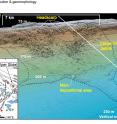Great Barrier Reef protecting against landslides, tsunamis
Related images
(click to enlarge)
The world-famous Australian reef is providing an effective barrier against landslide-induced tsunamis, new research shows. What has developed into the Great Barrier Reef was not always a barrier reef - it was once a fringing reef and did not offer the same protective quality. This is because the coast at this time was much closer to the source of the tsunamis, said lead author of the paper, Associate Professor Jody Webster, from the Geocoastal Research Group at the University of Sydney.
The research shows a shallow underwater landslide occurred 20,000-14,000 years ago, which caused a tsunami 2-3m high. The tsunami could have impacted Aborigines living at the time along estuaries and on islands off the paleo-coastline, which has since receded under the rising sea levels that followed the last ice age.
The 7km-wide landslide occurred off the edge of the continental shelf causing the tsunami on the paleo-coastline lying between Airlie Beach and Townsville in the northern State of Queensland.
Details of the discovery of the submarine landslide and tsunami were published this week in Marine Geology. The international team of researchers used sophisticated computer simulations to recreate what the tsunami would have looked like.
Associate Professor Webster said similar landslides under the sea could occur without our knowledge.
"There is a relatively low chance that a similar submarine landslide with the potential to cause a tsunami of up to three metres or more would happen today," Associate Professor Webster said.
"However, if one did occur, our findings suggest that the Great Barrier Reef is doing us a great service because of its ability to absorb some of that potential wave energy."
Just how much energy would be absorbed and what the extent of damage could be done by rising sea levels and tsunamis or king tides is the subject of future research.
In reaching their findings, Dr Jon Hill from the University of York created visual simulations of the tsunami impact at today's sea level, as well as at a depth of -70m, where the paleo-coastline was before it receded to its current position and was replaced at the shelf edge by the formation of the Great Barrier Reef.
The research team has named the submarine landslide the Viper Slide because of its location adjacent to Viper Reef.
"The discovery of the Viper Slide is the first solid evidence that submarine landslides existed on the Great Barrier Reef," said Dr Robin Beaman from James Cook University - a member of the expedition that mapped the slide.
Source: University of Sydney
Other sources
- Great Barrier Reef protecting against landslides, tsunamisfrom Science DailyWed, 25 Nov 2015, 16:40:38 UTC
- Great Barrier Reef protecting against landslides, tsunamisfrom PhysorgWed, 25 Nov 2015, 16:30:52 UTC
- The (fish) eyes have itfrom PhysorgTue, 24 Nov 2015, 12:00:15 UTC
- Scientists say feeding fish soy, not fish, more sustainablefrom PhysorgSun, 22 Nov 2015, 20:00:12 UTC
- Scientists say feeding fish soy, not fish, more sustainablefrom AP HealthSun, 22 Nov 2015, 16:30:09 UTC

